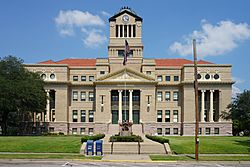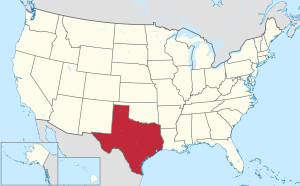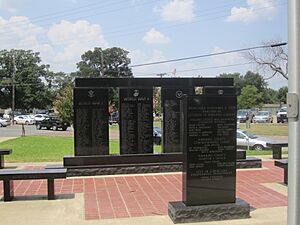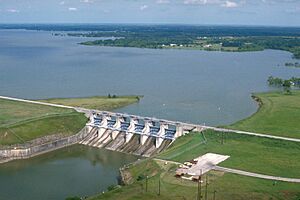Navarro County, Texas facts for kids
Quick facts for kids
Navarro County
|
|
|---|---|

The Navarro County Courthouse in Corsicana
|
|

Location within the U.S. state of Texas
|
|
 Texas's location within the U.S. |
|
| Country | |
| State | |
| Founded | April 25, 1846 |
| Named for | José Antonio Navarro |
| Seat | Corsicana |
| Largest city | Corsicana |
| Area | |
| • Total | 1,086 sq mi (2,810 km2) |
| • Land | 1,010 sq mi (2,600 km2) |
| • Water | 76 sq mi (200 km2) 7.0% |
| Population
(2020)
|
|
| • Total | 52,624 |
| • Density | 48.457/sq mi (18.709/km2) |
| Time zone | UTC−6 (Central) |
| • Summer (DST) | UTC−5 (CDT) |
| Congressional district | 6th |

Navarro County is a county in the U.S. state of Texas. A county is like a smaller area within a state. In 2020, about 52,624 people lived here. Its main city, or county seat, is Corsicana.
The county is named after José Antonio Navarro. He was an important leader from Texas who signed the Texas Declaration of Independence. Navarro County is part of a larger area around Dallas and Fort Worth.
Contents
Navarro County was officially created in 1846. It was formed from a larger area called Robertson County.
Geography and Location
Navarro County covers a total area of about 1,086 square miles. This is roughly the size of a small state. About 76 square miles of this area is covered by water.
These are some of the major highways that run through Navarro County:
 Interstate 45
Interstate 45 U.S. Highway 287
U.S. Highway 287 State Highway 14
State Highway 14 State Highway 22
State Highway 22 State Highway 31
State Highway 31 State Highway 75
State Highway 75 State Highway 309
State Highway 309
Neighboring Counties
Navarro County shares borders with these other counties:
- Henderson County (to the northeast)
- Freestone County (to the southeast)
- Limestone County (to the south)
- Hill County (to the southwest)
- Ellis County (to the north)
| Historical population | |||
|---|---|---|---|
| Census | Pop. | %± | |
| 1850 | 2,190 | — | |
| 1860 | 5,996 | 173.8% | |
| 1870 | 8,879 | 48.1% | |
| 1880 | 21,702 | 144.4% | |
| 1890 | 26,373 | 21.5% | |
| 1900 | 43,374 | 64.5% | |
| 1910 | 47,070 | 8.5% | |
| 1920 | 50,624 | 7.6% | |
| 1930 | 60,507 | 19.5% | |
| 1940 | 51,308 | −15.2% | |
| 1950 | 39,916 | −22.2% | |
| 1960 | 34,423 | −13.8% | |
| 1970 | 31,150 | −9.5% | |
| 1980 | 35,323 | 13.4% | |
| 1990 | 39,926 | 13.0% | |
| 2000 | 45,124 | 13.0% | |
| 2010 | 47,735 | 5.8% | |
| 2020 | 52,624 | 10.2% | |
| U.S. Decennial Census 1850–2010 2010 2020 |
|||
In 2020, the population of Navarro County was 52,624 people. The county has a mix of different groups. About 51% of the people were White, and about 12% were Black or African American. Around 30% of the population was Hispanic or Latino.
In 2000, there were about 16,491 households in the county. Many households (34%) had children under 18 living with them. The average household had about 2.65 people. The median age of people in the county was 35 years old. This means half the people were older than 35 and half were younger.
Media and News
Navarro County is in the area where TV stations from Dallas and Fort Worth are watched. Some of these stations include KDFW-TV and KXAS-TV. People in Navarro County can also watch TV stations from nearby cities like Waco and Tyler.
The local newspaper for the area is called the Corsicana Daily Sun.
Navarro County has several cities, towns, and smaller communities.
Cities
Towns
Unincorporated Communities
These are smaller communities that are not officially cities or towns.
Ghost Town
- Pisgah (A ghost town is a place where most people have left)
Students in Navarro County attend schools in different school districts.
- Blooming Grove Independent School District
- Bynum Independent School District
- Corsicana Independent School District
- Dawson Independent School District
- Ennis Independent School District
- Fairfield Independent School District
- Frost Independent School District
- Hubbard Independent School District
- Kerens Independent School District
- Mildred Independent School District
- Rice Independent School District
- Wortham Independent School District
The entire county is also served by Navarro College. This college offers higher education and training programs.
See also
 In Spanish: Condado de Navarro para niños
In Spanish: Condado de Navarro para niños


